Junior Geologist
It all started with a book. This last Summer, a friend gave me the audio version of Bill Bryson's "A Short History of Nearly Everything." It's a fascinating story about the history of science and runs about 18 hours in length. Perfect for listening to on the road.

During the rendition, Mr. Bryson covers a section on the beginnings of geology, wherein European gentlemen-thinkers of the late 1700's set out to discover the causes behind Earth's many puzzling features. Having listened to this program a number of times, I began to take greater notice of the rocks and landscapes passing me by.
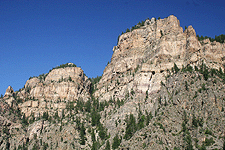
Later in the year, I found myself browsing the aisles of a local Border's bookstore and was seduced by a sale item that caught my eye. The volume was called "Earth" and contained a collection of beautiful photographs taken of the planet's surface from space. The images were spectacular to gaze at, but how the various structures came about was beyond my understanding.
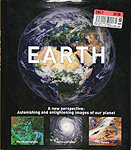
All of this simmered in my mind for a while until I decided to find out more. As it happened, another couple of sale books crossed my path. "Rocks and Minerals of the World" from Half Price Books and "The Complete Guide to Rocks and Minerals" from Borders beckoned to me. Scanning them each several times from cover to cover, I discovered there was a lot to know regarding what goes on under our feet.
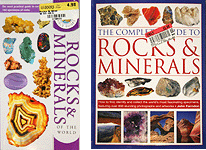
At first, the sheer variety of rock and mineral types was overwhelming, along with their chemical compositions and crystaline structures. Added to that were all the different tests that existed to help determine just what you were holding in your hand. Of course you had to consider all of the large-scale geologic processes as well, such as vulcanism, erosion and plate tectonics. Eventually, with exposure, this bank of information would become more managable.
So, in October, I found myself embarcing on the last big road trip of the year. Photo assignments were scheduled to take me to housing developments in Kentucky, Tennessee, North Carolina, Maryland, New York and Connecticut. While roaming one community being built in Kentucky, I happened to spy a number of unusual rocks in the soil. They had a reddish-orange cast that I had never seen before. I picked up a few and thought that I might be able to use my new books to identify them. That's what got me started.
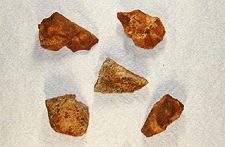
In Tennessee I came across more unfamiliar rocks covering the ground of a recently excavated zone. Many were spherical with banded interiors. Others had an markedly organic appearance. Again, I picked up a few for later investivation. Not long after, a thought occured to me. Wouldn't it be neat to pick up rocks at sites in all 48 states? If I did, I would have a ground sampling of the entire United States. A seed was planted.
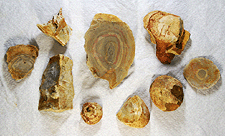
As I traveled up the Eastern coast of the US, I continued to pick through freshly unearthed rocks at construction sites. These seemed to be ideal spots to come by samples. Some places yeilded many interesting stones, while others were less forthcoming. Maryland, for example, surprised me. I observed a backhoe digging into the soil where a propane tank was to be installed. The shovel brought up generous amounts of soft clay, but nothing solid. Peering down, the walls of the trench revealed several layers of smooth material in assorted colors. Harder substances were totally missing.
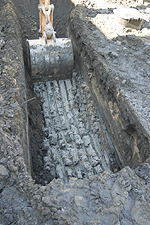
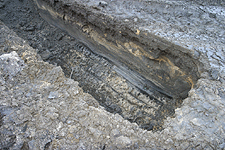
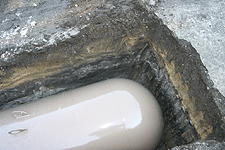
Connecticut, however, was another matter. Building sites there were teeming with rocks. The samples I collected from various sites around the state displayed a wide range of shapes, weights, consistencies, surface textures, patterns and colors. Obviously there had been a lot going on in Connecticut's past.
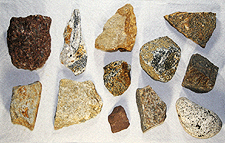
Next, I ventured into New York and took note of the rocky cliffs along the Palisades Parkway close to New York City. Along one side of the river were massive stone walls extending to significant heights. This was a grand departure from my experience at the Kansas-Missouri border, where layer upon layer of yellow and gray limestone pile up.
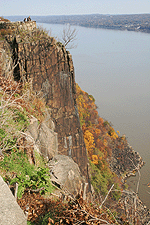
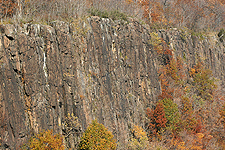
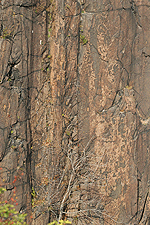
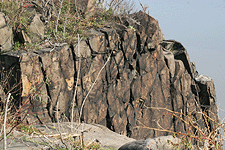
In fact, the New York, New Jersey and Connecticut countrysides had large rocks strewn across the landscape practically everywhere I looked. There was certainly no shortage.
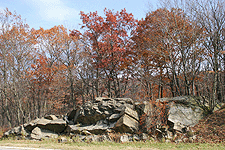
On my way home, I happened to pass through Pennsylvania. Near Pittsburgh, I stopped at several spots to dig materials out of the open cliff faces that presented themselves. Here, I found not hard stone, but a predominance of gray, flaky shale. This delicate substance was very difficult to keep all in one piece.
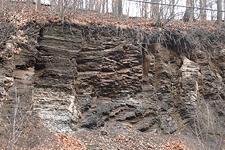
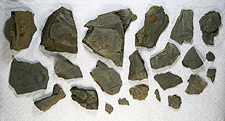
Encountering Missouri, I viewed its numerous highway cutouts with new eyes. As most everyone knows, the exposed walls of hills and mountains next to roads reveal the true nature of what lies beneath the ground's surface. As is often the case, vast underground rock beds exist hidden away. Yet, they are constantly there supporting us in spite of our minimal awareness.
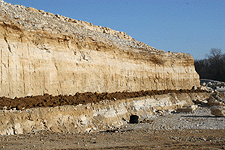
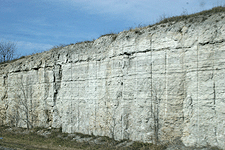
Returning to Kansas City, I had lunch with my friend Pat and told him of my adventures and new field of interest. To my surprise, he started mentioning all sorts of facts regarding the subject. As it turns out, Pat took some geology courses back in his university days and has maintained an ongoing fascination to present day.
Encouraging me to bring a few samples to our next weekly lunch, I did so. (Over the course of my trip I collected 14 individual plastic bags.) I dumped the contents of one container out onto a table and Pat began to point out details that revealed many of the stones' identities. At the time, this was pretty amazing to me. To a novice like myself, significant attributes were meaningless. These were all just rocks that happened to look a little different from each other.
After several weeks of ongoing examination, I eventually presented Pat with enough samples to illustrate the basics. I still can't immediately pick up a rock and know what it is, but I do know a little more as to what to look for. To help me out, Pat produced a couple of publications for my review. One was an old textbook from 1971 called "Physical Geology" and the other was more recent, titled "Messages In Stone - Colorado's Colorful Geology". Both texts were quite enlightening.
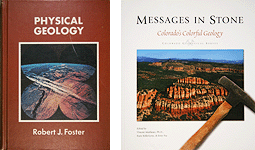
Again, scavenging through bookstore bargain bins, I acquired another three books for my growing library. They were "Earth - The Making, Shaping and Workings of a Planet", "Encyclopedia of Minerals", and "Simon & Schuter's Guide to Rocks & Minerals". Having multiple pictures of rock types to examine, it bacame easier to see the differences.
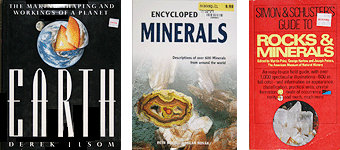
Following my purchases, I was asked to go on another photo shoot in Cedar Rapids, Iowa. I set out on my quest to add more stones to my collection but was thwarted by Iowa's hearty top soil. I discovered, as in Maryland, Iowa's clay layers go down pretty deep. No wonder it's such a great area for growing things. Unfortunately, though, it left me with nothing to show.
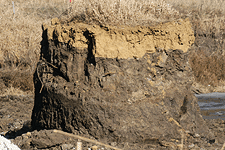
This, then brings us pretty much up to date. I have been reading sections of the books I have bought and have learned a bit about igneous, metamorphic and sedimentary rocks, plus some on the vast assortment of minerals out there. Mostly, my interest lies in the composition of underground materials and how they got there. Not so much in collecting pretty gemstones.
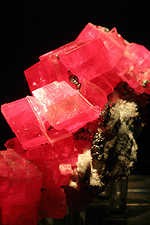
Since it will be several months before I go out on the road again, I am left with the pictures I have taken for sources of enlightenment. Fortunately, I had the presence of mind to capture lots of images of landscapes and rock formations over the last three and one-half years. Now I can go back and look at them in a new light, and will hopefully have new insights in the process. I am particularly anxious to review my shots of Arches National Park, Colorado National Monument, the Badlands, Bighorn National Forest, and Devil's Tower.
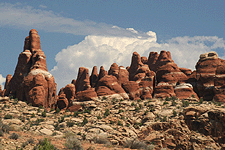
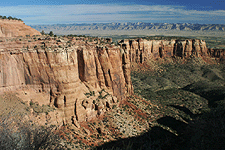
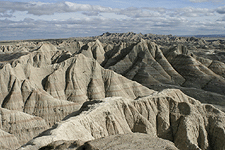
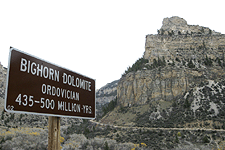
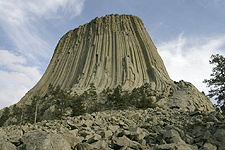
As for readers out there, who might have similar interests, I hope my initial pursuits can be of value. Again, I suggest visiting areas where new home development are going on. There seems to be a great deal of excavation in these places and people are expected to be looking over these sites. Also, zones where road construction has taken place are good for observation, although they are often inconvenient to access. Stream beds likewise seem to be a logical place to see geology in action. Personally, I have not had the best of luck in such locales and have found the materials there to be highly eroded. But that shouldn't keep you from looking. If you are lucky enough to gain access to a quarry or mine, well, have the time of your life.
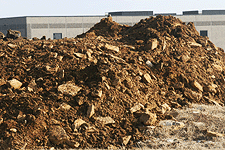
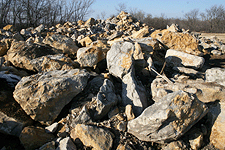
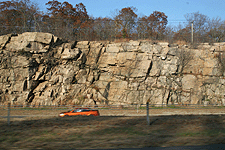
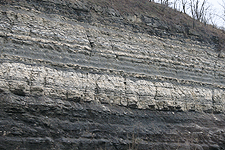
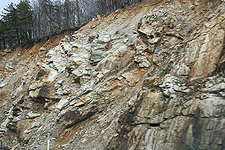
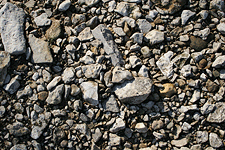
Okay. That's about it. Good luck in your endeavors and stay out of harm's way. -- Tom

During the rendition, Mr. Bryson covers a section on the beginnings of geology, wherein European gentlemen-thinkers of the late 1700's set out to discover the causes behind Earth's many puzzling features. Having listened to this program a number of times, I began to take greater notice of the rocks and landscapes passing me by.

Later in the year, I found myself browsing the aisles of a local Border's bookstore and was seduced by a sale item that caught my eye. The volume was called "Earth" and contained a collection of beautiful photographs taken of the planet's surface from space. The images were spectacular to gaze at, but how the various structures came about was beyond my understanding.

All of this simmered in my mind for a while until I decided to find out more. As it happened, another couple of sale books crossed my path. "Rocks and Minerals of the World" from Half Price Books and "The Complete Guide to Rocks and Minerals" from Borders beckoned to me. Scanning them each several times from cover to cover, I discovered there was a lot to know regarding what goes on under our feet.

At first, the sheer variety of rock and mineral types was overwhelming, along with their chemical compositions and crystaline structures. Added to that were all the different tests that existed to help determine just what you were holding in your hand. Of course you had to consider all of the large-scale geologic processes as well, such as vulcanism, erosion and plate tectonics. Eventually, with exposure, this bank of information would become more managable.
So, in October, I found myself embarcing on the last big road trip of the year. Photo assignments were scheduled to take me to housing developments in Kentucky, Tennessee, North Carolina, Maryland, New York and Connecticut. While roaming one community being built in Kentucky, I happened to spy a number of unusual rocks in the soil. They had a reddish-orange cast that I had never seen before. I picked up a few and thought that I might be able to use my new books to identify them. That's what got me started.

In Tennessee I came across more unfamiliar rocks covering the ground of a recently excavated zone. Many were spherical with banded interiors. Others had an markedly organic appearance. Again, I picked up a few for later investivation. Not long after, a thought occured to me. Wouldn't it be neat to pick up rocks at sites in all 48 states? If I did, I would have a ground sampling of the entire United States. A seed was planted.

As I traveled up the Eastern coast of the US, I continued to pick through freshly unearthed rocks at construction sites. These seemed to be ideal spots to come by samples. Some places yeilded many interesting stones, while others were less forthcoming. Maryland, for example, surprised me. I observed a backhoe digging into the soil where a propane tank was to be installed. The shovel brought up generous amounts of soft clay, but nothing solid. Peering down, the walls of the trench revealed several layers of smooth material in assorted colors. Harder substances were totally missing.



Connecticut, however, was another matter. Building sites there were teeming with rocks. The samples I collected from various sites around the state displayed a wide range of shapes, weights, consistencies, surface textures, patterns and colors. Obviously there had been a lot going on in Connecticut's past.

Next, I ventured into New York and took note of the rocky cliffs along the Palisades Parkway close to New York City. Along one side of the river were massive stone walls extending to significant heights. This was a grand departure from my experience at the Kansas-Missouri border, where layer upon layer of yellow and gray limestone pile up.




In fact, the New York, New Jersey and Connecticut countrysides had large rocks strewn across the landscape practically everywhere I looked. There was certainly no shortage.

On my way home, I happened to pass through Pennsylvania. Near Pittsburgh, I stopped at several spots to dig materials out of the open cliff faces that presented themselves. Here, I found not hard stone, but a predominance of gray, flaky shale. This delicate substance was very difficult to keep all in one piece.


Encountering Missouri, I viewed its numerous highway cutouts with new eyes. As most everyone knows, the exposed walls of hills and mountains next to roads reveal the true nature of what lies beneath the ground's surface. As is often the case, vast underground rock beds exist hidden away. Yet, they are constantly there supporting us in spite of our minimal awareness.


Returning to Kansas City, I had lunch with my friend Pat and told him of my adventures and new field of interest. To my surprise, he started mentioning all sorts of facts regarding the subject. As it turns out, Pat took some geology courses back in his university days and has maintained an ongoing fascination to present day.
Encouraging me to bring a few samples to our next weekly lunch, I did so. (Over the course of my trip I collected 14 individual plastic bags.) I dumped the contents of one container out onto a table and Pat began to point out details that revealed many of the stones' identities. At the time, this was pretty amazing to me. To a novice like myself, significant attributes were meaningless. These were all just rocks that happened to look a little different from each other.
After several weeks of ongoing examination, I eventually presented Pat with enough samples to illustrate the basics. I still can't immediately pick up a rock and know what it is, but I do know a little more as to what to look for. To help me out, Pat produced a couple of publications for my review. One was an old textbook from 1971 called "Physical Geology" and the other was more recent, titled "Messages In Stone - Colorado's Colorful Geology". Both texts were quite enlightening.

Again, scavenging through bookstore bargain bins, I acquired another three books for my growing library. They were "Earth - The Making, Shaping and Workings of a Planet", "Encyclopedia of Minerals", and "Simon & Schuter's Guide to Rocks & Minerals". Having multiple pictures of rock types to examine, it bacame easier to see the differences.

Following my purchases, I was asked to go on another photo shoot in Cedar Rapids, Iowa. I set out on my quest to add more stones to my collection but was thwarted by Iowa's hearty top soil. I discovered, as in Maryland, Iowa's clay layers go down pretty deep. No wonder it's such a great area for growing things. Unfortunately, though, it left me with nothing to show.

This, then brings us pretty much up to date. I have been reading sections of the books I have bought and have learned a bit about igneous, metamorphic and sedimentary rocks, plus some on the vast assortment of minerals out there. Mostly, my interest lies in the composition of underground materials and how they got there. Not so much in collecting pretty gemstones.

Since it will be several months before I go out on the road again, I am left with the pictures I have taken for sources of enlightenment. Fortunately, I had the presence of mind to capture lots of images of landscapes and rock formations over the last three and one-half years. Now I can go back and look at them in a new light, and will hopefully have new insights in the process. I am particularly anxious to review my shots of Arches National Park, Colorado National Monument, the Badlands, Bighorn National Forest, and Devil's Tower.





As for readers out there, who might have similar interests, I hope my initial pursuits can be of value. Again, I suggest visiting areas where new home development are going on. There seems to be a great deal of excavation in these places and people are expected to be looking over these sites. Also, zones where road construction has taken place are good for observation, although they are often inconvenient to access. Stream beds likewise seem to be a logical place to see geology in action. Personally, I have not had the best of luck in such locales and have found the materials there to be highly eroded. But that shouldn't keep you from looking. If you are lucky enough to gain access to a quarry or mine, well, have the time of your life.






Okay. That's about it. Good luck in your endeavors and stay out of harm's way. -- Tom

